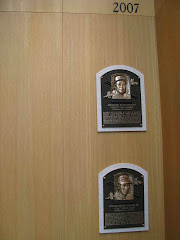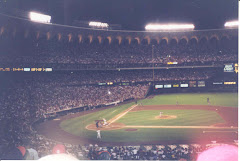 On the recommendation of a student that I taught last semester and this semester, I read Pete Gray's book - One Armed Wonder, which tells the story of the St. Louis Browns outfielder.
On the recommendation of a student that I taught last semester and this semester, I read Pete Gray's book - One Armed Wonder, which tells the story of the St. Louis Browns outfielder.In the first class that he took, which I taught, we used to heroic passages to write summaries and research papers. I used the tale of Adam Bender, and he found this book and the story of Jim Abbot as comparable tales to the life of Adam Bender, a one-legged boy who still plays baseball (he's a catcher) and high school wrestling as well as quarterbacking for youth football.
I've always said that despite age, we don't look down to find our heroes, and the reality is that Bender who is currently 10 has more leadership and heart than most grown people that I know. To be honest, I wish I had more of what makes him tick.
The same can be said about Pete Gray who always wanted to play at Yankee Stadium despite losing his right arm in a truck accident. World War Two's diluted player pool gave him the opportunity to do that, but he gave himself the ability to make the opportunity count. He learned to hit one armed. He learned to catch a ball and throw it to the infield with one arm. Nobody stopped the game for him, and despite the fact that the switch from glove to arm with the ball tossed into the air in the meantime took a few seconds, Gray did what it took to get better.
He even hit 5 home runs at Memphis in 1944 before making it to the St. Louis Browns in 1945. This was one year removed from their historic 1944 campaign where they played the Cardinals in their first and only World Series losing 4 games to 2 (and almost winning a third - quite an accomplishment for perennial cellar dwellers - even in a time where players were there because they were unable to be drafted for war service). Quite simply, he wasn't an also ran or a gate attraction like some people made him to be.
Instead, he was inspiration to the young and the injured war vets, who he had more respect for than they had for him (and that's saying something).
He was a hero - be it from roughly the same area that I live in (give or take a few hours) or from the world in general. He didn't let life get in his way. He didn't let those people who belittled him get him down. He fought to be on the diamond and to give his best, and he truly did. Be it in the majors or the minors, he was a great part of the game. In addition, his 11 strikeouts in 77 games would be something that many of today's free swingers took note of. Gray might not have had the muscle power to do one-armed Mickey Mantle shots in the pros, but he knew enough about small ball to get the hits, the bunts, and the seeing eye dribblers that put him on base to steal second. In this, he was a fierce base runner (more minors than majors, but still).
And like Jim Abbot (who wanted to be more like Nolan Ryan than Pete Gray) tossing a no hitter to celebrate his abilities and competitive nature, there is pride in any person overcoming their obstacles (be they disabilities or doubts or being picked second) to be great. Abbott did his no hitter against Manny Ramirez, Jim Thome, and Albert Belle in 1993. Those Indians weren't exactly the Cleveland Spiders.
Heart is all about what you make of your circumstances.
Pete Gray may not have had a right arm, but he had a lot of heart.

















